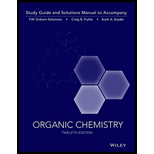
Interpretation:
The reactions of the Walden cycle likely to take place with the overall inversion of configuration and those likely to occur with the overall retention of the configuration are to be determined. The configurations of the other compounds in the Walden cycle are to be determined. The Walden cycle, based on the use of thionyl chloride instead of
Concept introduction:
Reaction sequences involve the conversion of one
These sequences involve a number of steps carried out by different reagents. Sometimes, different reagents give the same products.
Electrophiles are electron-deficient species, which has positive or partially positive charge. Lewis acids are electrophiles, which accept electron pair.
Nucleophiles are electron-rich species, which has negative or partially negative charge. Lewis bases are nucleophiles, which donate electron pair.
Substitution reaction: A reaction in which one of the hydrogen atoms of a hydrocarbon or a functional group is substituted by any other functional group is called substitution reaction.
Nucleophilic substitution reaction is a reaction in which an electron-rich nucleophile attacks the positive or partial positive charge of an atom or a group of atoms to replace a leaving group.
An
An
The involvement of nearby nucleophile substituent to the reaction center in the substitution process is known as neighboring group participation.
Such participation results in an increase of
In this participation, two
When the order of progression from the group of highest priority to that of the next highest priority is clockwise, it is said to be the
When the order of progression from the group of highest priority to that of the next highest priority is anticlockwise, then it is said to be the
Want to see the full answer?
Check out a sample textbook solution
Chapter 6 Solutions
Organic Chemistry, 12e Study Guide/Student Solutions Manual
- If we measure the rotation angle of a sample in a polarimeter and it is zero, the sample….(1). It is a 1.00 M aqueous solution of a pure substance of rotational power exactly equal to 100.(2). It is optically inactive.(3). It is an equimolar mixture of enantiomers of the same compound.(4). It is a mixture of right-handed and left-handed substances.arrow_forwardFor conjugated C=C with carbonyl group or another double bond, lower frequency for vibration and lower force constant is needed? Why?arrow_forwardonly answer (iv) (v) (vi) thank youarrow_forward
- Predict the characteristic infrared absorptions of the functional groups in the following molecules. (a) ethyl acetate (b) pentanamidearrow_forward99,00%6 ملا ت مها احمد (A A) B) ma not بوك هلا حد ده A6 99.9999% Br a.) Given our discussions of this mechanism express in a reaction coordinate diagram the two reactions above. * Please exaggerate scale for clarity* +HBrarrow_forwardAn unknown sugar is known to equilibrate between two forms, I and II, in aqueous solution. Thisequilibration can be followed by measuring the optical rotation of aqueous solutions of isolatedsamples of form I and II. When species I was dissolved in pure water and the optical rotation was measured, it gave aspecific rotation of [?] = +42.0°. Over time, this value decreased to a constant value of [?]= +0.2°. • When species II was dissolved in pure water and the optical rotation was measured, it gave aspecific rotation of [?] = -54.0°. Over time, this value decreased to constant value of [?]= +0.2°. • In each case, both forms I and II were shown to be present in the mixture at the end of theexperiment. Calculate the ratio of the two forms I and II present at equilibrium and comment on anyassumptions made in making that calculation.arrow_forward
- 7. Kindly please provide the answer only ASAParrow_forward15. A simulation using the polarizable continuum model (PCM) predicts that the carbonyl stretching frequency of formaldehyde is 1810 cm¹ in the gas phase, ~1800 cm¹ in solution with benzene, and 1780 cm¹ in solution with water. In which of these environments would you anticipate the C- O bond having the shortest bond length? Explain your reasoning.arrow_forwardCalculate the enantiomeric excess for the sample of (S)- ibuprofen sample and (R)-ibuprofen sample based on the data in attached image?arrow_forward
- (a) Calculate the number of C-H stretching vibrations for: (i) p-difluorobenzene; (ii) fluorobenzene.arrow_forward(b) The following heterocyclic compound (2) is currently being evaluated in numerous clinical trials to investigate its potential as a possible treatment for COVID-19. Using your knowledge and the criteria for aromaticity in your response, determine and discuss if the compound is aromatic, non- aromatic or anti-aromatic. HN' 'N' CI `N'arrow_forwardAttach a schematic diagram showing the procedure involved in the determination of observed rotation and calculation of specific rotation.arrow_forward

 EBK A SMALL SCALE APPROACH TO ORGANIC LChemistryISBN:9781305446021Author:LampmanPublisher:CENGAGE LEARNING - CONSIGNMENT
EBK A SMALL SCALE APPROACH TO ORGANIC LChemistryISBN:9781305446021Author:LampmanPublisher:CENGAGE LEARNING - CONSIGNMENT
 ChemistryChemistryISBN:9781305957404Author:Steven S. Zumdahl, Susan A. Zumdahl, Donald J. DeCostePublisher:Cengage Learning
ChemistryChemistryISBN:9781305957404Author:Steven S. Zumdahl, Susan A. Zumdahl, Donald J. DeCostePublisher:Cengage Learning Chemistry: An Atoms First ApproachChemistryISBN:9781305079243Author:Steven S. Zumdahl, Susan A. ZumdahlPublisher:Cengage Learning
Chemistry: An Atoms First ApproachChemistryISBN:9781305079243Author:Steven S. Zumdahl, Susan A. ZumdahlPublisher:Cengage Learning




